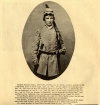
|
Confederate Double Barrel Shotgun "HF Strohecker Charleston, SC" |
This is a nice example of an English double barrel shotgun with engraving imported by the firm HF Strohecker of Charleston, South Carolina. The action consists of back-action locks, both marked "HF Strohecker" with light scrolls. The 14-gauge damascus twist barrels measure 30.5" and were proofed in Birmingham, England with the initials "WS"...WC Scott? Webley & Scott? Top rib of barrels clearly engraved "HF Strohecker. Charleston, S.C." See photos. Furniture consists of an iron buttplate and large-bowed trigger guard with engraved English-style finials. The patchbox, nameplate on the top of the wrist, and barrel wedge escutcheon are made of German silver while the forend cap is cast pewter. This pewter cap may have been added later here in America. Stock is one-piece English walnut with a checkered wrist. While this isn't an expensive top-tier English shotgun (usually London) it has nice architecture, quality engraving, and is well-built. The Port of Charleston was an ideal place for a merchant during the 1850's and 60's as it provided a direct avenue to European goods. In addition to Charleston, other Southern merchants such as Cofer of Portsmouth, VA and Kernaghan of New Orleans were also strong importers of English shotguns up to the beginning of the Civil War when the Union blockade began to be put into effect. Here is an example of a New Orleans Kernaghan-marked shotgun we found a few years ago: http://www.antiquearmsinc.com/new-orleans-dealer-marked-double-barrel-shotgun-antique.htm With a shortage of suitable military weapons, double barrel shotguns played a significant role in arming the Confederacy, especially during the early part of the Civil War. As troops waited for the promise of better weapons, it was not unusual for Confederate infantry regiments to be armed entirely with these commercially-made double barrel shotguns. Please note the photos of Confederate soldiers with shotguns below. Some of these men fought with double barrels well into 1862 and I suspect some regiments in the Western theater may have used them into part of 1863. As the Confederate Ordnance Department was able to procure modern P53 Enfield Rifled Muskets through the blockade, establish a limited manufacturing base for arms, and develop resourceful battlefield scrounging to procure additional weapons from the Union, the double barrel shotgun's role was diminished greatly. The remainder of these double barrel guns left in the field were primarily used by the cavalry where they were highly effective...at least in short range combat. While there were many double barrels in the South prior to the Civil War, what makes this one special is that we know it was imported, retailed, and marked to a specific Southern merchant, all but guaranteeing it was in the South throughout the Civil War. Given it was imported through Strohecker, it is highly probable that this gun was in ear's distance of the first shots of the Civil War when the Confederate batteries in Charleston opened fire on Fort Sumter in April, 1861. Henry F. Strohecker was born in South Carolina on January 1, 1810 and died on October 17, 1869. The 1860 US federal census lists him as a merchant in Charleston, South Carolina with real estate valued at $36,000 and a personal estate worth $21,000. In addition to sporting guns, Strohecker made great efforts to obtain the best and most modern weapons available for the Confederacy in the months leading up to South Carolina's secession from the Union (Dec. 1860) and the attack on Fort Sumter the following April. One of the guns Strohecker was after was the new breech-loading Maynard Carbine. The book, Civil War Carbines, volume II, p. 72 states: "In addition to the six hundred fifty purchased by the State of Georgia, as many as eight hundred Maynard carbines appear to have been purchased by militia companies in South Carolina and Louisiana. As of November 24, 1860, T.W. Radcliff of Columbia, South Carolina requested thirty .50 caliber twenty inch barrel Maynard carbines, and several other militia companies in Charleston and Columbia were interested in purchasing Maynards. During this period, the Charleston, South Carolina firm of H.F. Strohecker advertised Maynards for sale." Overall condition grades to NRA Antique Good+. This gun looks like it was put to work but is in remarkably good condition for 150 years old and something that survived the decades of hardship following the Civil War when money was tight and everything of use was worked into the ground. Through that perspective, this is a nice Southern shotgun. The metal has a pleasing smooth gray patina that is beginning to turn to light brown with slightly worn edges but no pitting. Nice markings on the lock and barrels indicating retail by Strohecker. See photos. Engraving is a bit worn in spots but good overall and completely visible. Back-action locks are still in working order although the hammer has a little bit of play and the original nipples are worn. Wood is in Very Good condition overall...there are a couple of minor cracks in non-critical areas...one near the top of the buttplate and the other is at the front of the forend cap (see photos). One small chip repair just above the front portion of the left lock. Wooden ramrod is a Southern-made replacement...looks great. In ten years, this the fourth Southern-retailed shotgun we have been fortunate enough to find and the only one from a South Carolina dealer. A wonderful piece of Southern and Confederate history! Item# 1678 SOLD |
 |
 |
||
 |
 |
 |
 |
 |
 |
 |
 |
 |
 |
 |
 |
 |
 |
||
 |
 |
 |
 |
 |
 |
 |
 |
 |
 |
 |
 |
 |
 |